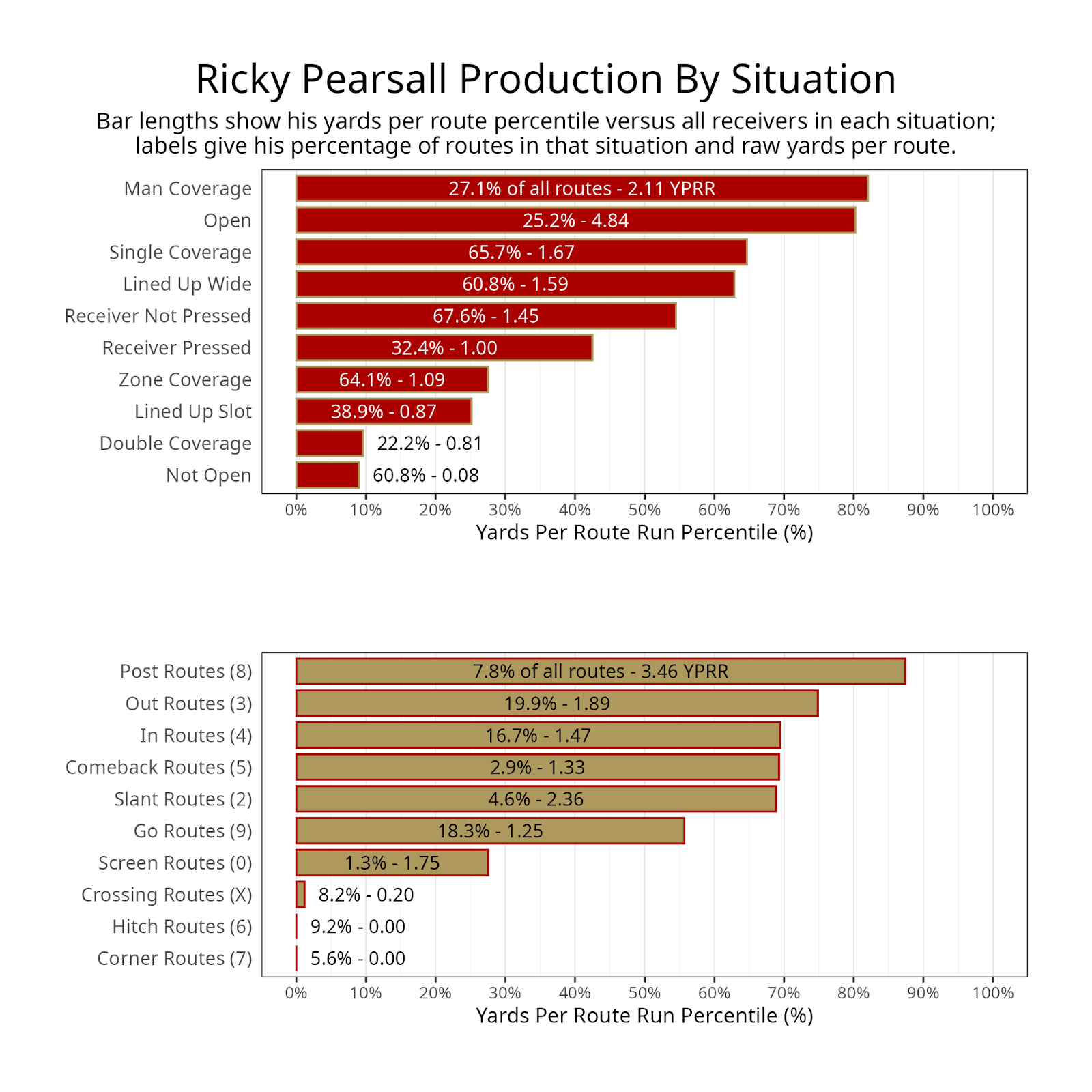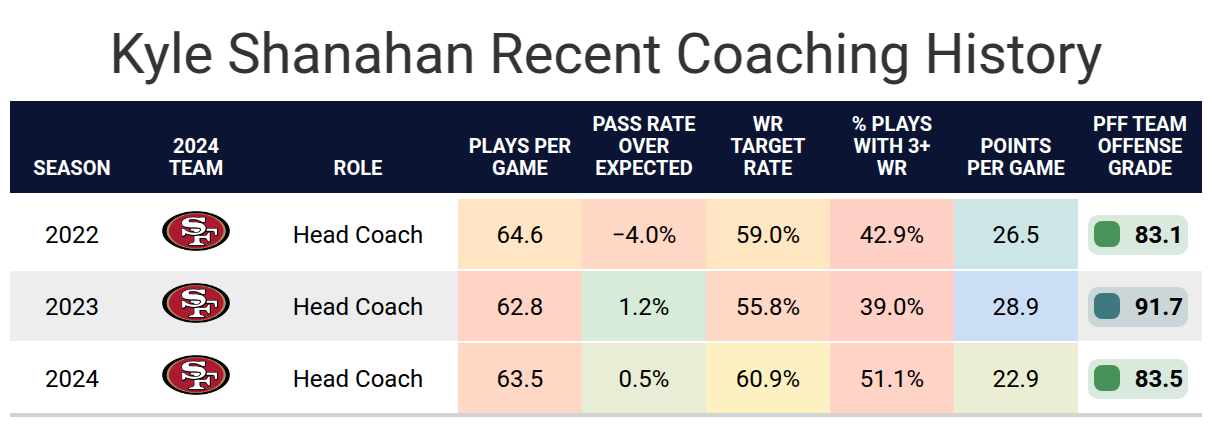- Ricky Pearsall shines at the end of the season: Pearsall gained over 200 yards over the San Francisco 49ers‘ last two games, building some momentum for next season.
- Significant competition for touches: The 49ers have one of the best receiving tight ends and receiving running backs, as well as other talented wide receivers, on the roster. Pearsall will need to pass at least one of them on the pecking order in order to be a fantasy starter this season.
- Subscribe to PFF+: Get access to player grades, PFF Premium Stats, fantasy football rankings, all of the PFF fantasy draft research tools and more!
Estimated Reading Time: 5 minutes

PFF’s Fantasy Football Player Profile series delivers the most in-depth fantasy football analysis available for the 2025 season.
Using PFF’s exclusive data, we evaluate player performance, competition for touches and how teammates and coaching staffs
Last updated: 7:15 a.m. Wednesday, June 11
Player performance
During the 2024 offseason, the San Francisco 49ers knew they had too many good players and weren’t going to be able to pay all of them. Both Brandon Aiyuk and Deebo Samuel were about to have massive cap hits in 2025, so to prepare for life without one of them, the team drafted Ricky Pearsall with the 31st pick in the NFL draft. While there were rumors that one would get traded before the season, San Francisco re-signed Aiyuk to a longer-term deal and kept Samuel for one more year in hopes of another Super Bowl run.
This meant not much was expected of Pearsall for his rookie season. Pearsall was shot when a teenager was trying to steal his watch. Luckily, the wound wasn’t life-threatening, so Pearsall only missed the first six weeks of the season. The 49ers ended up needing Pearsall immediately, as Jauan Jennings missed Weeks 7 and 8 and Aiyuk suffered his season-ending injury in Week 7. When Jennings returned, he took Aiyuk’s spot rather than returning to the slot. This meant Pearsall was the 49ers' primary slot receiver over the rest of the season.
He was off to a promising start, with 11 receptions for 131 yards and a touchdown in the first three weeks, along with a 39-yard run. However, he followed that up with three games without a reception, and two games with one reception each. While it was understandable that Samuel, Jennings and tight end George Kittle would receive most of the targets, it would have been good to see Pearsall a little more involved in the offense.
He started to bounce back in Week 16 with four receptions for 37 yards. In Week 17, he had his best game of the season with eight receptions for 141 yards and a touchdown against the Detroit Lions in a surprisingly competitive game. The 49ers opted to rest some starters and pull other starters early in Week 18 to give other players opportunities. This allowed Pearsall to be an every-down player for one game. He caught six passes for 69 yards and a touchdown.
While his role was primarily the third receiver in three-receiver sets, Pearsall played notably better when lined up out wide, finishing with 1.59 yards per route run out wide compared to 0.87 in the slot. Most slot receivers generally play better against zone coverage than man, but Pearsall was a clear exception. He averaged 2.11 yards per route run against man compared to 1.09 against zone.
Pearsall tweaked his hamstring during OTAs, which will force him out until training camp. This should have a minimal impact on his season, but it’s possible his hamstring injury takes a turn for the worse.


Projected role
The 49ers traded Samuel to the Washington Commanders this offseason. This ensures that Pearsall will at least be among the top three wide receivers on the depth chart. There is no guarantee that Aiyuk will be ready for the season. Aiyuk is expected to be the X receiver, while Jennings is the Z and Pearsall plays the slot when everyone is healthy. The 49ers signed Demarcus Robinson in free agency, and he could take the X spot until Aiyuk is ready. However, it’s at least possible Jennings could play X while Pearsall is the Z in base if Aiyuk is out. There is also a chance Pearsall and Jennings could swap in three-receiver sets.
Pearsall will need to consistently play in two-receiver sets in order to have a shot at fantasy value this season. From Weeks 7-17 last year, Jennings played 71% of San Francisco's offensive snaps in two-receiver sets, while Samuel played 66%, Pearsall played 28% and Chris Conley played 24%. Pearsall should be able to beat out Robinson for those base snaps but beating out Aiyuk or Jennings will be more difficult.
Even then, the 49ers have George Kittle and Christian McCaffrey, who will take a high percentage of those targets. The 49ers have been the rare team in recent seasons to have four fantasy-starting skill players. It’s practically impossible to have five, so beating out either Aiyuk or Jennings is an absolute necessity.


Impact of teammates
The 49ers have retained their long-time head coach, Kyle Shanahan. The 49ers are consistently near the bottom of the league in 11 personnel usage, which is why it’s so important for Pearsall to play significantly in two-receiver sets. They also don’t throw as much to wide receivers because they have Kittle and McCaffrey.
Luckily, the 49ers have become more pass-heavy since Brock Purdy emerged as the team’s starting quarterback. Purdy has graded relatively well in the offense, displaying good accuracy, and the combination of Purdy and Shanahan’s system has been one of the best offenses in the league. That combination is why Pearsall is worth considering, despite the significant competition for touches, over other second-year wide receivers who similarly didn’t become fantasy starters during their rookie seasons.


Bottom line
Ricky Pearsall is a lottery ticket at wide receiver. The most likely scenario is you won’t be able to trust starting him, but if he works his way up the wide receiver depth chart, there is a path to him becoming a top-20 fantasy wide receiver.

Footnotes
- Statistics in tables and charts were chosen based on their ability to predict future fantasy performance on a per-game or per-opportunity basis or to describe the player relative to others at the same position.
- “Opportunities” are defined as passing dropbacks, rushing attempts and routes run as a receiver.
- Numbers are provided either by season or based on the past three years. For rookies, only college statistics are included. For non-rookies, only NFL statistics are considered, regardless of whether they played in college within the previous three years.
- As college competition is easier than NFL competition, most rookies are likely to see a decline from their historical numbers.
- Only FBS data is considered for college players and comparisons.
- Kneel-downs are removed from rushing data to provide cleaner quarterback rushing rate statistics.
- The table colors in this article range from blue (indicating good/high) to red (indicating bad/low).
- All percentiles and color codings compare the given player to others with a high sample of opportunities. Generally, the cutoff is one-third of the possible opportunities in the sample. If a player does not meet the threshold, they are still included in the comparison, though their results may appear better or worse than expected due to the smaller, less predictive sample size.
- Information on utilization classifications and their importance can be found here for running backs, wide receivers and tight ends.



 © 2025 PFF - all rights reserved.
© 2025 PFF - all rights reserved.